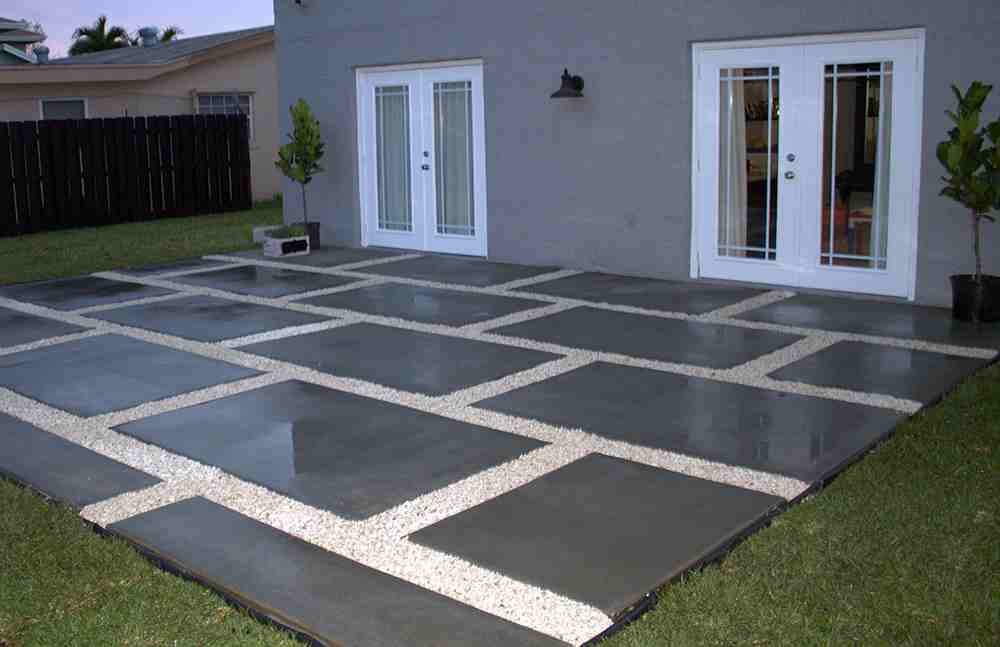Absolutely! Installing paver patios over existing concrete is a great way to revamp your outdoor space without the hassle of removing the old slab. It’s a cost-effective and time-saving solution that can transform your backyard into a stylish, functional area for entertaining or relaxing. Plus, with a variety of paver designs and colors available, you can customize the look to suit your taste. This method also provides added durability, as the concrete foundation offers a stable base for the pavers. Whether you’re looking to update your patio, driveway, or walkway, View Scape Design offers a seamless blend of aesthetics and practicality.
Inspect the Concrete Surface
Before installing pavers over an existing concrete surface, it is crucial to inspect the condition of the concrete. A thorough inspection helps determine if the concrete can serve as a suitable base for the pavers. Look for any major cracks, uneven areas, or significant damage. Minor imperfections, such as small cracks or slightly uneven spots, can be addressed during the installation process. However, if the concrete is severely damaged or has large, unstable cracks, it may not be a viable foundation. In such cases, repairing the concrete or opting to remove it entirely might be necessary. Ensuring a solid and stable base is essential for the longevity and stability of the paver patio.
Clean the Concrete Surface
Once the concrete surface has been inspected and deemed suitable, the next step is to clean it thoroughly. Removing dirt, debris, and any stains from oil, grease, or organic matter is essential for ensuring proper adhesion and stability of the pavers. A pressure washer is an effective tool for this task, as it can remove stubborn dirt and grime with ease. Alternatively, a strong cleaning solution and a stiff-bristle brush can be used. The goal is to create a clean, smooth surface free of any contaminants that could interfere with the paver patio installation. A well-prepared concrete base will help ensure a successful and long-lasting paver patio.
Apply a Bonding Agent (Optional)
Applying a bonding agent is an optional but recommended step to enhance the adhesion between the existing concrete surface and the new paver layer. A bonding agent acts as a glue, helping to secure the pavers in place and preventing them from shifting over time. This step is particularly beneficial if the concrete surface has minor imperfections or if there are concerns about the pavers’ stability. The bonding agent is typically applied with a roller or brush, ensuring even coverage across the entire surface. Once applied, it is important to allow the bonding agent to dry according to the manufacturer’s instructions before proceeding to the next steps.
Lay a Sand Bed
Laying a sand bed over the concrete is a critical step in the installation process. The sand bed provides a flexible, leveling layer that helps to accommodate any minor imperfections in the concrete and ensures that the pavers are evenly supported. To create the sand bed, spread a layer of sand evenly across the concrete surface. The thickness of the sand layer can vary, but it is generally recommended to be around 1 to 2 inches thick. After spreading the sand, use a compactor to compress and level it. This compacted sand bed will create a stable base for the pavers, helping to ensure a smooth and even installation.
Install the Pavers

With the sand bed in place, the next step is to begin installing the pavers. Start by laying the pavers in the desired pattern, ensuring that they fit snugly together. Common patterns include herringbone, basket weave, and running bond, among others. As you lay the pavers, use spacers to maintain consistent gaps between them, which will later be filled with sand. It is important to check the level of the pavers frequently, making any necessary adjustments to ensure a flat and even surface. If any pavers need to be trimmed to fit around edges or obstacles, use a wet saw or paver cutter to make precise cuts. Taking the time to lay the pavers correctly will result in a professional-looking and durable patio.
Cut Pavers to Fit
Cutting pavers to fit around edges, corners, or any obstacles is an essential part of achieving a polished and professional finish. Use a wet saw or a paver cutter to make clean, precise cuts that allow the pavers to fit snugly in the designated areas. Measure each space carefully before cutting to ensure accuracy. It is also important to wear safety gear, such as goggles and gloves, when cutting pavers to protect yourself from dust and debris. Once the pavers have been cut and placed, double-check the overall layout to ensure that all pieces fit together seamlessly. Properly cut and fitted pavers will enhance the overall appearance and stability of the patio, ensuring that it looks great and functions well for years to come.
Fill the Joints
Filling the joints between the pavers is a crucial step in the installation process. Polymeric sand is commonly used for this purpose, as it helps to lock the pavers in place and prevent weed growth. Begin by sweeping the polymeric sand over the surface of the pavers, ensuring it fills the joints completely. Use a broom to push the sand into the gaps, and continue adding sand until all joints are filled. Once the joints are filled, lightly mist the surface with water to activate the polymer in the sand. This will cause the sand to harden and bond the pavers together. Be careful not to over-water, as this can wash away the sand. Allow the sand to set according to the manufacturer’s instructions before using the patio. Properly filled joints contribute to the structural integrity and longevity of the paver patio.
Compact the Pavers

After filling the joints with sand, it is important to compact the pavers to ensure they are firmly set in place. A plate compactor is the ideal tool for this task. Run the compactor over the entire surface of the patio, making sure to cover all areas evenly. The vibration from the compactor will help the sand settle into the joints and the pavers to sit securely in the sand bed. If necessary, add more sand to the joints and compact again to ensure they are fully filled. This step is essential for preventing the pavers from shifting or becoming loose over time. A well-compacted patio will be stable and durable, providing a solid surface for years to come.
Final Inspection and Cleaning
Once the pavers have been compacted, perform a final inspection to ensure everything is in order. Check for any uneven areas, loose pavers, or gaps in the joints. Make any necessary adjustments to ensure the patio is level and secure. Clean the surface of the patio to remove any remaining sand, dust, or debris. A leaf blower can be useful for this task, as it can remove loose sand without disturbing the joints. A clean, well-inspected patio not only looks better but also ensures that the installation is complete and ready for use. Taking the time to perform a thorough inspection and cleaning will help to ensure the long-term success of your paver patio.
Benefits of Installing Pavers Over Concrete
There are several benefits to installing pavers over an existing concrete surface. One of the most significant advantages is cost savings. Removing old concrete can be labor-intensive and expensive, but laying pavers over it can save both time and money. Additionally, pavers are highly durable and can withstand the elements better than many other materials. They are also flexible, which means they can accommodate slight movements in the ground without cracking. This flexibility reduces the likelihood of damage and extends the life of the patio. Pavers also come in a wide variety of colors, shapes, and sizes, allowing for a high degree of customization and aesthetic appeal. Overall, installing pavers over concrete is an efficient and cost-effective way to enhance your outdoor space.
Considerations
While installing pavers over concrete has many benefits, there are also some important considerations to keep in mind. One of the main factors is height. Adding a layer of pavers will raise the height of the patio, which may affect steps, door thresholds, and drainage. It is important to ensure that the new height does not create any tripping hazards or interfere with the functionality of doors and other structures. Additionally, proper drainage is crucial to prevent water from pooling on the patio surface. The patio should have a slight slope to direct water away from buildings and other areas where it could cause damage. Finally, the condition of the concrete is a key consideration. If the concrete is severely damaged or unstable, it may be better to remove it entirely before installing the pavers. Taking these factors into account will help ensure a successful installation.
Proper Drainage
Proper drainage is a critical aspect of any patio installation, especially when laying pavers over existing concrete. Water pooling on the surface can lead to a range of issues, including damage to the pavers and the underlying concrete. To ensure proper drainage, the patio should have a slight slope, typically around 1/8 inch per foot, to direct water away from structures and towards appropriate drainage areas. Additionally, installing a drainage system, such as a French drain or channel drain, can help manage water runoff effectively. Ensuring proper drainage will protect your investment and prevent potential problems down the line.
Maintenance and Longevity
Proper maintenance is essential to ensure the longevity of your paver patio. Regular cleaning is important to remove dirt, debris, and stains. A pressure washer can be used periodically to keep the patio looking its best. It is also important to monitor the joints and add more sand as needed to keep them filled and prevent weeds from growing. Sealing the pavers every few years can help to protect them from stains and weather damage, as well as enhance their color and appearance. With proper maintenance, a paver patio can provide a beautiful and durable outdoor space for many years.
Enhancing Aesthetic Appeal
Paver patios offer a wide range of design possibilities that can enhance the aesthetic appeal of your outdoor space. With a variety of colors, shapes, and patterns available, you can create a unique and visually appealing patio that complements your home’s style. Consider using different paver colors to create borders or accents, or incorporate patterns such as herringbone, basket weave, or running bond for added interest. Adding features such as built-in seating, planters, or lighting can further enhance the functionality and appearance of the patio. By taking advantage of the design flexibility that pavers offer, you can create an outdoor space that is both beautiful and functional.
Conclusion
In conclusion, installing paver patios over existing concrete is a smart and efficient way to enhance your outdoor living space. This method not only saves time and money but also provides a durable and aesthetically pleasing surface. With the ability to choose from a wide range of paver styles and colors, you can easily customize your patio to match your personal taste and home décor. Whether you’re aiming for a modern, rustic, or classic look, paver patios over concrete offer a versatile solution that blends beauty with functionality, ensuring your outdoor area becomes a welcoming retreat for years to come.
